Business Environment Report: Unilever Plc Analysis, HND Business
VerifiedAdded on 2020/07/22
|10
|2698
|94
Report
AI Summary
This report provides a thorough examination of the business environment, focusing on Unilever Plc. It begins with an introduction to the business environment and its significance. The report then delves into the interrelation between various organizational departments, such as human resources, marketing, finance, and production, and their impact on achieving organizational objectives. It also analyzes the company's organizational structure, including function-based, geography-based, product-based, and consumer-based structures. A key section of the report explores the impact of macro-environmental factors, using STEEPLE analysis to assess social, technological, environmental, economic, political, legal, and ethical factors. Furthermore, the report conducts an internal analysis of Unilever Plc, utilizing SWOT analysis to identify its strengths, weaknesses, opportunities, and threats. Finally, it examines the interrelation between macro-environmental factors and the organization's strengths and weaknesses, providing a comprehensive understanding of the company's position within its environment.
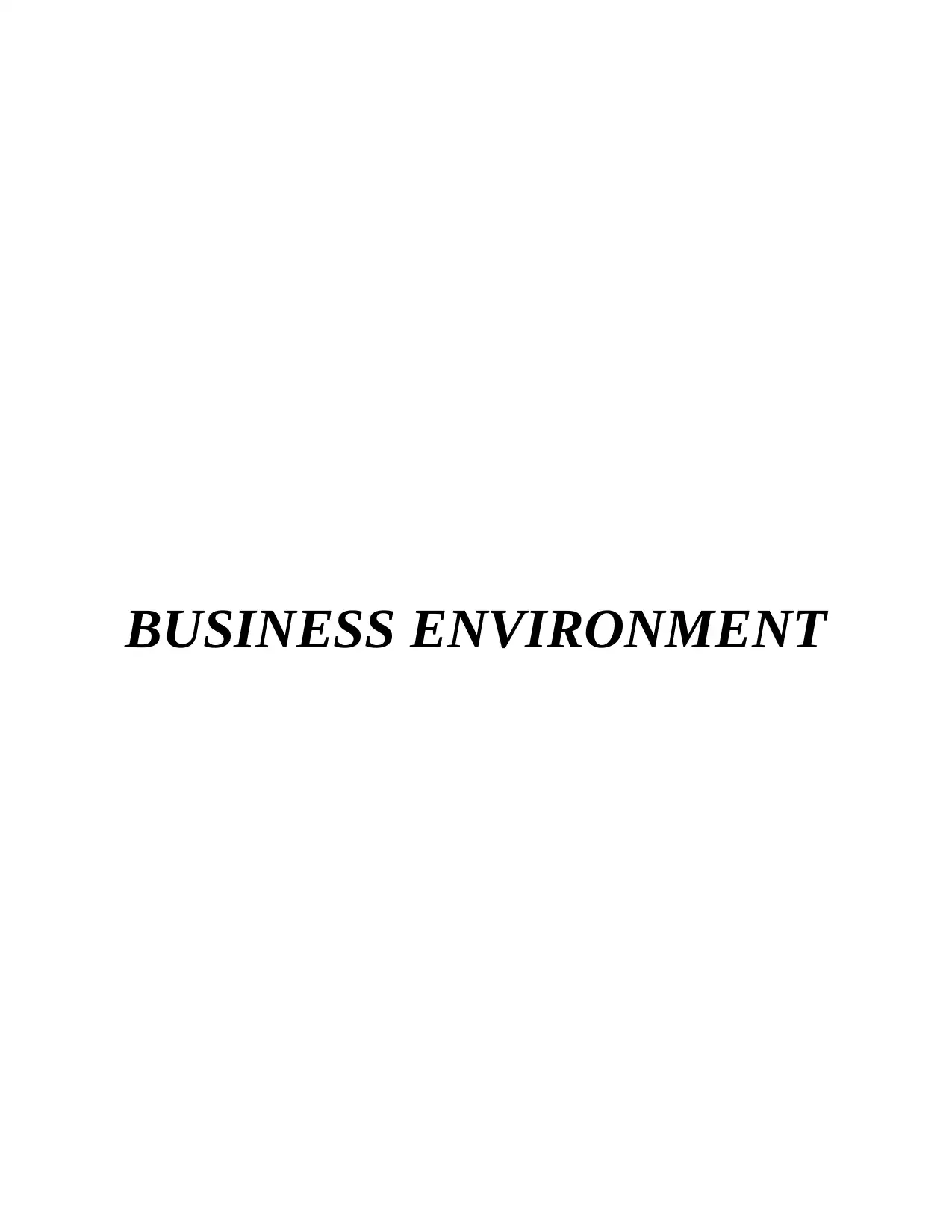
BUSINESS ENVIRONMENT
Paraphrase This Document
Need a fresh take? Get an instant paraphrase of this document with our AI Paraphraser
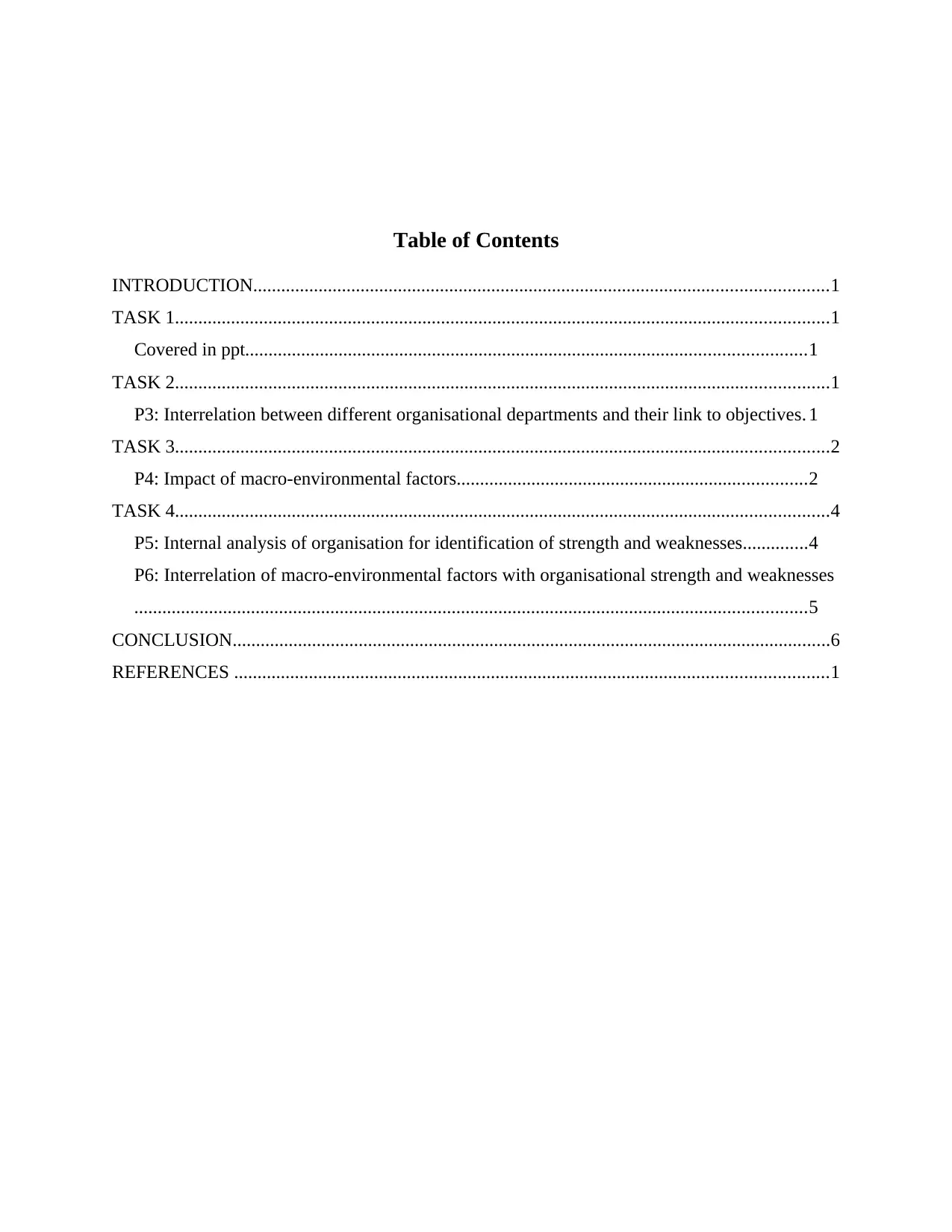
Table of Contents
INTRODUCTION...........................................................................................................................1
TASK 1............................................................................................................................................1
Covered in ppt........................................................................................................................1
TASK 2............................................................................................................................................1
P3: Interrelation between different organisational departments and their link to objectives. 1
TASK 3............................................................................................................................................2
P4: Impact of macro-environmental factors...........................................................................2
TASK 4............................................................................................................................................4
P5: Internal analysis of organisation for identification of strength and weaknesses..............4
P6: Interrelation of macro-environmental factors with organisational strength and weaknesses
................................................................................................................................................5
CONCLUSION................................................................................................................................6
REFERENCES ...............................................................................................................................1
INTRODUCTION...........................................................................................................................1
TASK 1............................................................................................................................................1
Covered in ppt........................................................................................................................1
TASK 2............................................................................................................................................1
P3: Interrelation between different organisational departments and their link to objectives. 1
TASK 3............................................................................................................................................2
P4: Impact of macro-environmental factors...........................................................................2
TASK 4............................................................................................................................................4
P5: Internal analysis of organisation for identification of strength and weaknesses..............4
P6: Interrelation of macro-environmental factors with organisational strength and weaknesses
................................................................................................................................................5
CONCLUSION................................................................................................................................6
REFERENCES ...............................................................................................................................1
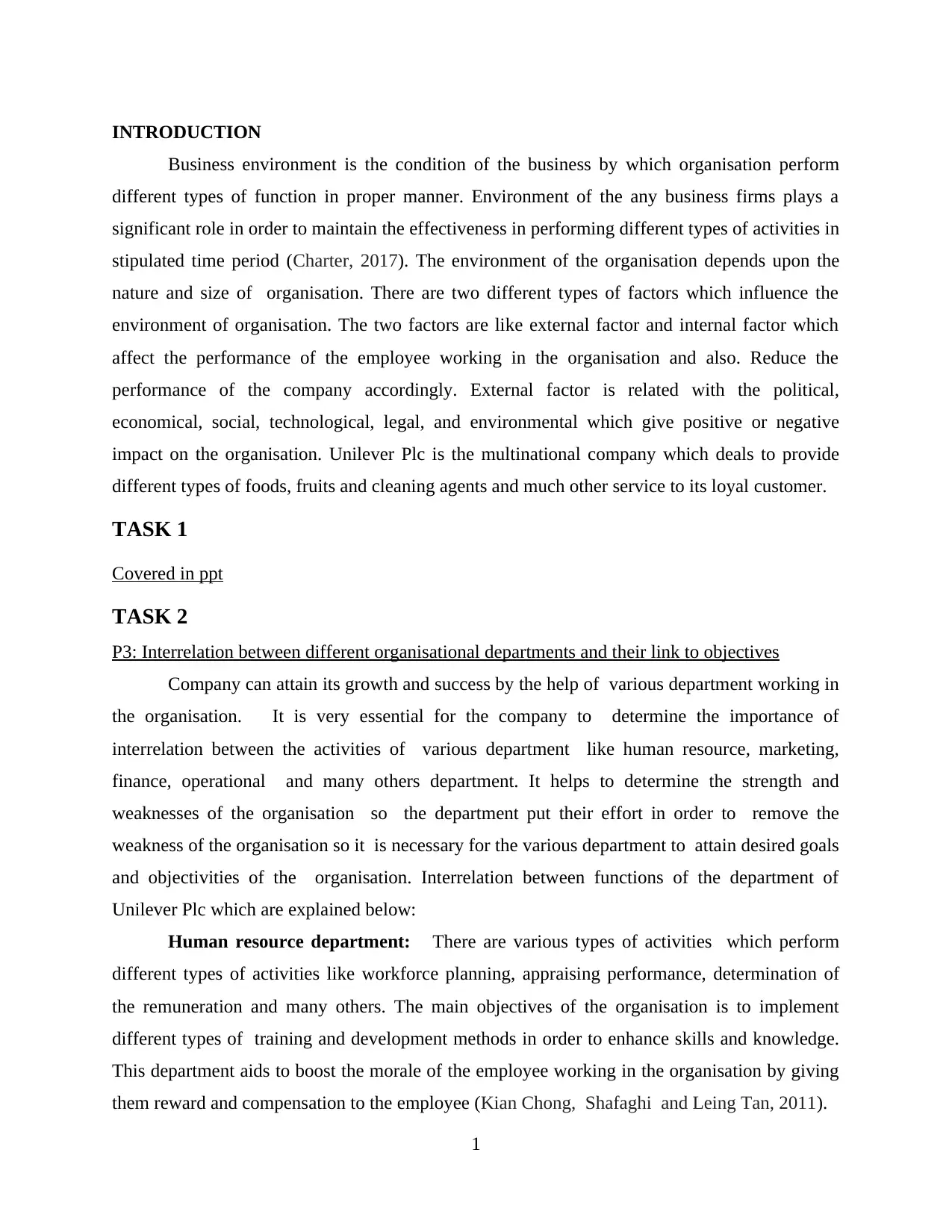
INTRODUCTION
Business environment is the condition of the business by which organisation perform
different types of function in proper manner. Environment of the any business firms plays a
significant role in order to maintain the effectiveness in performing different types of activities in
stipulated time period (Charter, 2017). The environment of the organisation depends upon the
nature and size of organisation. There are two different types of factors which influence the
environment of organisation. The two factors are like external factor and internal factor which
affect the performance of the employee working in the organisation and also. Reduce the
performance of the company accordingly. External factor is related with the political,
economical, social, technological, legal, and environmental which give positive or negative
impact on the organisation. Unilever Plc is the multinational company which deals to provide
different types of foods, fruits and cleaning agents and much other service to its loyal customer.
TASK 1
Covered in ppt
TASK 2
P3: Interrelation between different organisational departments and their link to objectives
Company can attain its growth and success by the help of various department working in
the organisation. It is very essential for the company to determine the importance of
interrelation between the activities of various department like human resource, marketing,
finance, operational and many others department. It helps to determine the strength and
weaknesses of the organisation so the department put their effort in order to remove the
weakness of the organisation so it is necessary for the various department to attain desired goals
and objectivities of the organisation. Interrelation between functions of the department of
Unilever Plc which are explained below:
Human resource department: There are various types of activities which perform
different types of activities like workforce planning, appraising performance, determination of
the remuneration and many others. The main objectives of the organisation is to implement
different types of training and development methods in order to enhance skills and knowledge.
This department aids to boost the morale of the employee working in the organisation by giving
them reward and compensation to the employee (Kian Chong, Shafaghi and Leing Tan, 2011).
1
Business environment is the condition of the business by which organisation perform
different types of function in proper manner. Environment of the any business firms plays a
significant role in order to maintain the effectiveness in performing different types of activities in
stipulated time period (Charter, 2017). The environment of the organisation depends upon the
nature and size of organisation. There are two different types of factors which influence the
environment of organisation. The two factors are like external factor and internal factor which
affect the performance of the employee working in the organisation and also. Reduce the
performance of the company accordingly. External factor is related with the political,
economical, social, technological, legal, and environmental which give positive or negative
impact on the organisation. Unilever Plc is the multinational company which deals to provide
different types of foods, fruits and cleaning agents and much other service to its loyal customer.
TASK 1
Covered in ppt
TASK 2
P3: Interrelation between different organisational departments and their link to objectives
Company can attain its growth and success by the help of various department working in
the organisation. It is very essential for the company to determine the importance of
interrelation between the activities of various department like human resource, marketing,
finance, operational and many others department. It helps to determine the strength and
weaknesses of the organisation so the department put their effort in order to remove the
weakness of the organisation so it is necessary for the various department to attain desired goals
and objectivities of the organisation. Interrelation between functions of the department of
Unilever Plc which are explained below:
Human resource department: There are various types of activities which perform
different types of activities like workforce planning, appraising performance, determination of
the remuneration and many others. The main objectives of the organisation is to implement
different types of training and development methods in order to enhance skills and knowledge.
This department aids to boost the morale of the employee working in the organisation by giving
them reward and compensation to the employee (Kian Chong, Shafaghi and Leing Tan, 2011).
1
⊘ This is a preview!⊘
Do you want full access?
Subscribe today to unlock all pages.

Trusted by 1+ million students worldwide
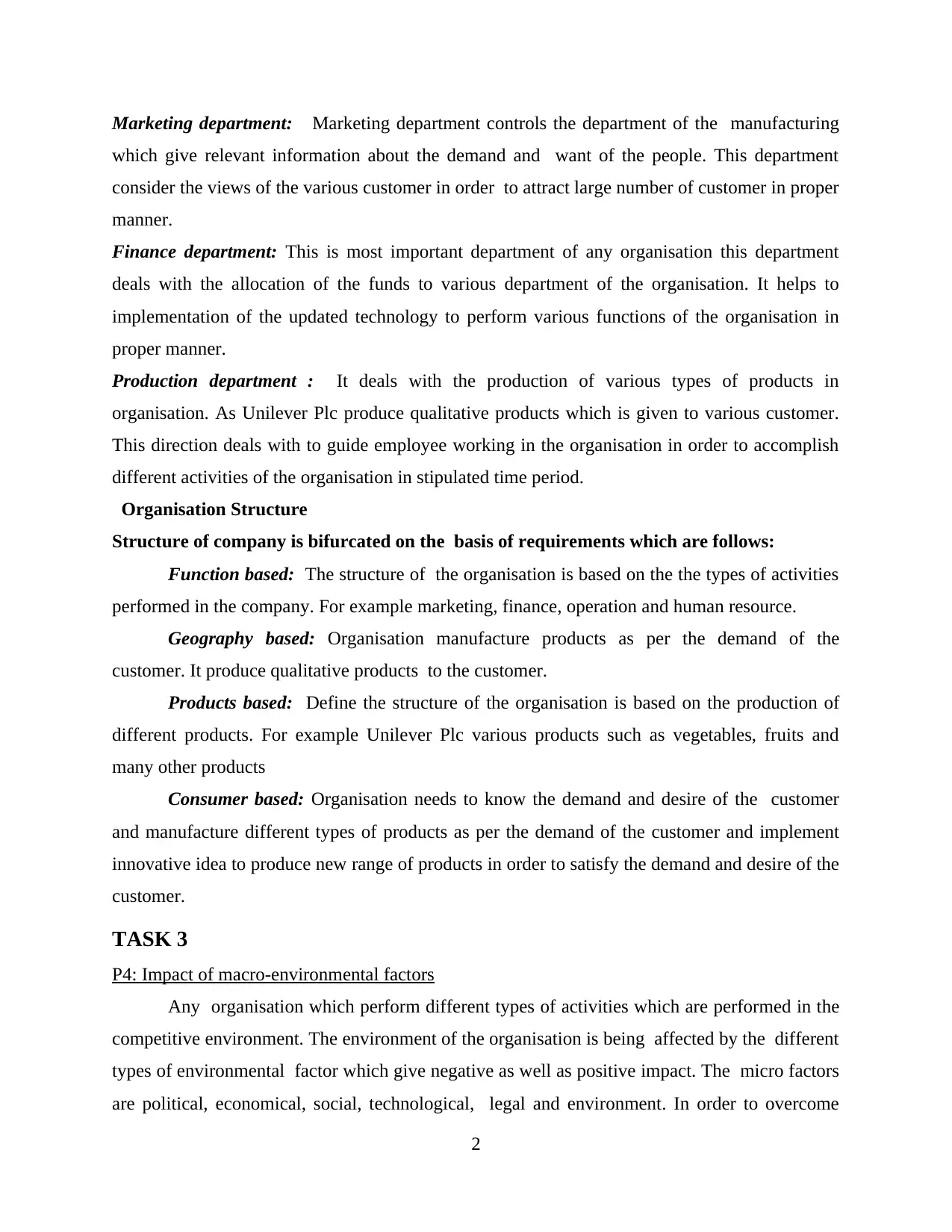
Marketing department: Marketing department controls the department of the manufacturing
which give relevant information about the demand and want of the people. This department
consider the views of the various customer in order to attract large number of customer in proper
manner.
Finance department: This is most important department of any organisation this department
deals with the allocation of the funds to various department of the organisation. It helps to
implementation of the updated technology to perform various functions of the organisation in
proper manner.
Production department : It deals with the production of various types of products in
organisation. As Unilever Plc produce qualitative products which is given to various customer.
This direction deals with to guide employee working in the organisation in order to accomplish
different activities of the organisation in stipulated time period.
Organisation Structure
Structure of company is bifurcated on the basis of requirements which are follows:
Function based: The structure of the organisation is based on the the types of activities
performed in the company. For example marketing, finance, operation and human resource.
Geography based: Organisation manufacture products as per the demand of the
customer. It produce qualitative products to the customer.
Products based: Define the structure of the organisation is based on the production of
different products. For example Unilever Plc various products such as vegetables, fruits and
many other products
Consumer based: Organisation needs to know the demand and desire of the customer
and manufacture different types of products as per the demand of the customer and implement
innovative idea to produce new range of products in order to satisfy the demand and desire of the
customer.
TASK 3
P4: Impact of macro-environmental factors
Any organisation which perform different types of activities which are performed in the
competitive environment. The environment of the organisation is being affected by the different
types of environmental factor which give negative as well as positive impact. The micro factors
are political, economical, social, technological, legal and environment. In order to overcome
2
which give relevant information about the demand and want of the people. This department
consider the views of the various customer in order to attract large number of customer in proper
manner.
Finance department: This is most important department of any organisation this department
deals with the allocation of the funds to various department of the organisation. It helps to
implementation of the updated technology to perform various functions of the organisation in
proper manner.
Production department : It deals with the production of various types of products in
organisation. As Unilever Plc produce qualitative products which is given to various customer.
This direction deals with to guide employee working in the organisation in order to accomplish
different activities of the organisation in stipulated time period.
Organisation Structure
Structure of company is bifurcated on the basis of requirements which are follows:
Function based: The structure of the organisation is based on the the types of activities
performed in the company. For example marketing, finance, operation and human resource.
Geography based: Organisation manufacture products as per the demand of the
customer. It produce qualitative products to the customer.
Products based: Define the structure of the organisation is based on the production of
different products. For example Unilever Plc various products such as vegetables, fruits and
many other products
Consumer based: Organisation needs to know the demand and desire of the customer
and manufacture different types of products as per the demand of the customer and implement
innovative idea to produce new range of products in order to satisfy the demand and desire of the
customer.
TASK 3
P4: Impact of macro-environmental factors
Any organisation which perform different types of activities which are performed in the
competitive environment. The environment of the organisation is being affected by the different
types of environmental factor which give negative as well as positive impact. The micro factors
are political, economical, social, technological, legal and environment. In order to overcome
2
Paraphrase This Document
Need a fresh take? Get an instant paraphrase of this document with our AI Paraphraser
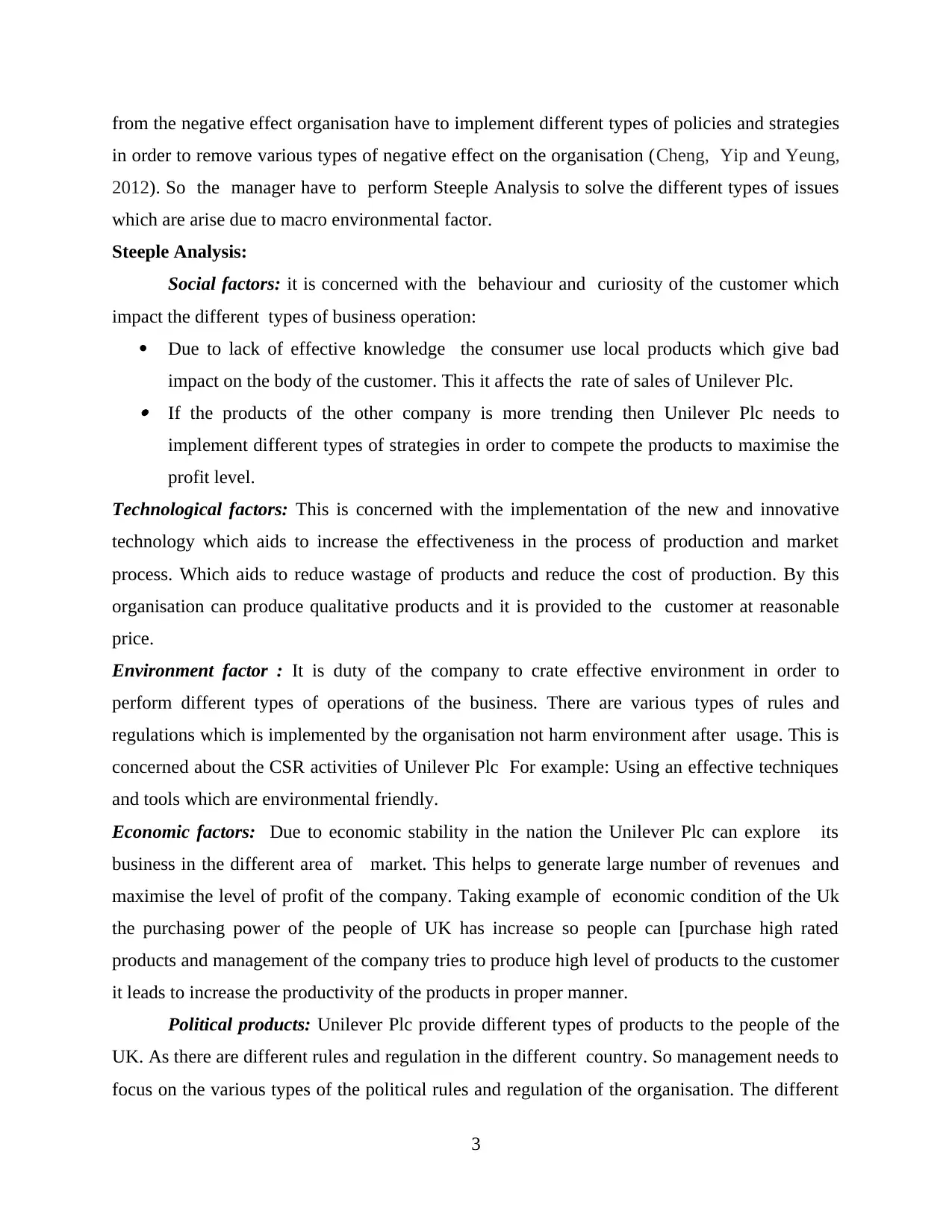
from the negative effect organisation have to implement different types of policies and strategies
in order to remove various types of negative effect on the organisation (Cheng, Yip and Yeung,
2012). So the manager have to perform Steeple Analysis to solve the different types of issues
which are arise due to macro environmental factor.
Steeple Analysis:
Social factors: it is concerned with the behaviour and curiosity of the customer which
impact the different types of business operation:
Due to lack of effective knowledge the consumer use local products which give bad
impact on the body of the customer. This it affects the rate of sales of Unilever Plc. If the products of the other company is more trending then Unilever Plc needs to
implement different types of strategies in order to compete the products to maximise the
profit level.
Technological factors: This is concerned with the implementation of the new and innovative
technology which aids to increase the effectiveness in the process of production and market
process. Which aids to reduce wastage of products and reduce the cost of production. By this
organisation can produce qualitative products and it is provided to the customer at reasonable
price.
Environment factor : It is duty of the company to crate effective environment in order to
perform different types of operations of the business. There are various types of rules and
regulations which is implemented by the organisation not harm environment after usage. This is
concerned about the CSR activities of Unilever Plc For example: Using an effective techniques
and tools which are environmental friendly.
Economic factors: Due to economic stability in the nation the Unilever Plc can explore its
business in the different area of market. This helps to generate large number of revenues and
maximise the level of profit of the company. Taking example of economic condition of the Uk
the purchasing power of the people of UK has increase so people can [purchase high rated
products and management of the company tries to produce high level of products to the customer
it leads to increase the productivity of the products in proper manner.
Political products: Unilever Plc provide different types of products to the people of the
UK. As there are different rules and regulation in the different country. So management needs to
focus on the various types of the political rules and regulation of the organisation. The different
3
in order to remove various types of negative effect on the organisation (Cheng, Yip and Yeung,
2012). So the manager have to perform Steeple Analysis to solve the different types of issues
which are arise due to macro environmental factor.
Steeple Analysis:
Social factors: it is concerned with the behaviour and curiosity of the customer which
impact the different types of business operation:
Due to lack of effective knowledge the consumer use local products which give bad
impact on the body of the customer. This it affects the rate of sales of Unilever Plc. If the products of the other company is more trending then Unilever Plc needs to
implement different types of strategies in order to compete the products to maximise the
profit level.
Technological factors: This is concerned with the implementation of the new and innovative
technology which aids to increase the effectiveness in the process of production and market
process. Which aids to reduce wastage of products and reduce the cost of production. By this
organisation can produce qualitative products and it is provided to the customer at reasonable
price.
Environment factor : It is duty of the company to crate effective environment in order to
perform different types of operations of the business. There are various types of rules and
regulations which is implemented by the organisation not harm environment after usage. This is
concerned about the CSR activities of Unilever Plc For example: Using an effective techniques
and tools which are environmental friendly.
Economic factors: Due to economic stability in the nation the Unilever Plc can explore its
business in the different area of market. This helps to generate large number of revenues and
maximise the level of profit of the company. Taking example of economic condition of the Uk
the purchasing power of the people of UK has increase so people can [purchase high rated
products and management of the company tries to produce high level of products to the customer
it leads to increase the productivity of the products in proper manner.
Political products: Unilever Plc provide different types of products to the people of the
UK. As there are different rules and regulation in the different country. So management needs to
focus on the various types of the political rules and regulation of the organisation. The different
3
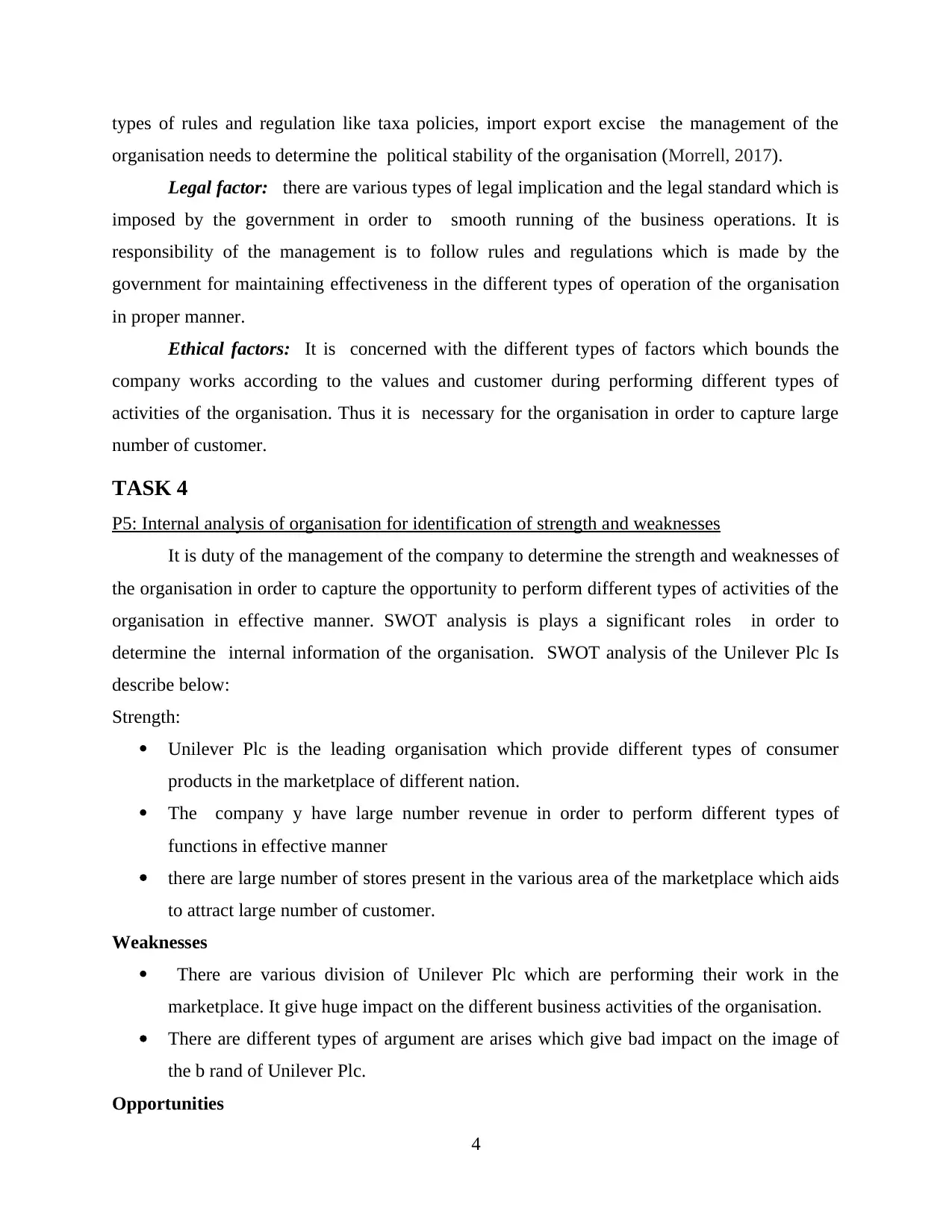
types of rules and regulation like taxa policies, import export excise the management of the
organisation needs to determine the political stability of the organisation (Morrell, 2017).
Legal factor: there are various types of legal implication and the legal standard which is
imposed by the government in order to smooth running of the business operations. It is
responsibility of the management is to follow rules and regulations which is made by the
government for maintaining effectiveness in the different types of operation of the organisation
in proper manner.
Ethical factors: It is concerned with the different types of factors which bounds the
company works according to the values and customer during performing different types of
activities of the organisation. Thus it is necessary for the organisation in order to capture large
number of customer.
TASK 4
P5: Internal analysis of organisation for identification of strength and weaknesses
It is duty of the management of the company to determine the strength and weaknesses of
the organisation in order to capture the opportunity to perform different types of activities of the
organisation in effective manner. SWOT analysis is plays a significant roles in order to
determine the internal information of the organisation. SWOT analysis of the Unilever Plc Is
describe below:
Strength:
Unilever Plc is the leading organisation which provide different types of consumer
products in the marketplace of different nation.
The company y have large number revenue in order to perform different types of
functions in effective manner
there are large number of stores present in the various area of the marketplace which aids
to attract large number of customer.
Weaknesses
There are various division of Unilever Plc which are performing their work in the
marketplace. It give huge impact on the different business activities of the organisation.
There are different types of argument are arises which give bad impact on the image of
the b rand of Unilever Plc.
Opportunities
4
organisation needs to determine the political stability of the organisation (Morrell, 2017).
Legal factor: there are various types of legal implication and the legal standard which is
imposed by the government in order to smooth running of the business operations. It is
responsibility of the management is to follow rules and regulations which is made by the
government for maintaining effectiveness in the different types of operation of the organisation
in proper manner.
Ethical factors: It is concerned with the different types of factors which bounds the
company works according to the values and customer during performing different types of
activities of the organisation. Thus it is necessary for the organisation in order to capture large
number of customer.
TASK 4
P5: Internal analysis of organisation for identification of strength and weaknesses
It is duty of the management of the company to determine the strength and weaknesses of
the organisation in order to capture the opportunity to perform different types of activities of the
organisation in effective manner. SWOT analysis is plays a significant roles in order to
determine the internal information of the organisation. SWOT analysis of the Unilever Plc Is
describe below:
Strength:
Unilever Plc is the leading organisation which provide different types of consumer
products in the marketplace of different nation.
The company y have large number revenue in order to perform different types of
functions in effective manner
there are large number of stores present in the various area of the marketplace which aids
to attract large number of customer.
Weaknesses
There are various division of Unilever Plc which are performing their work in the
marketplace. It give huge impact on the different business activities of the organisation.
There are different types of argument are arises which give bad impact on the image of
the b rand of Unilever Plc.
Opportunities
4
⊘ This is a preview!⊘
Do you want full access?
Subscribe today to unlock all pages.

Trusted by 1+ million students worldwide
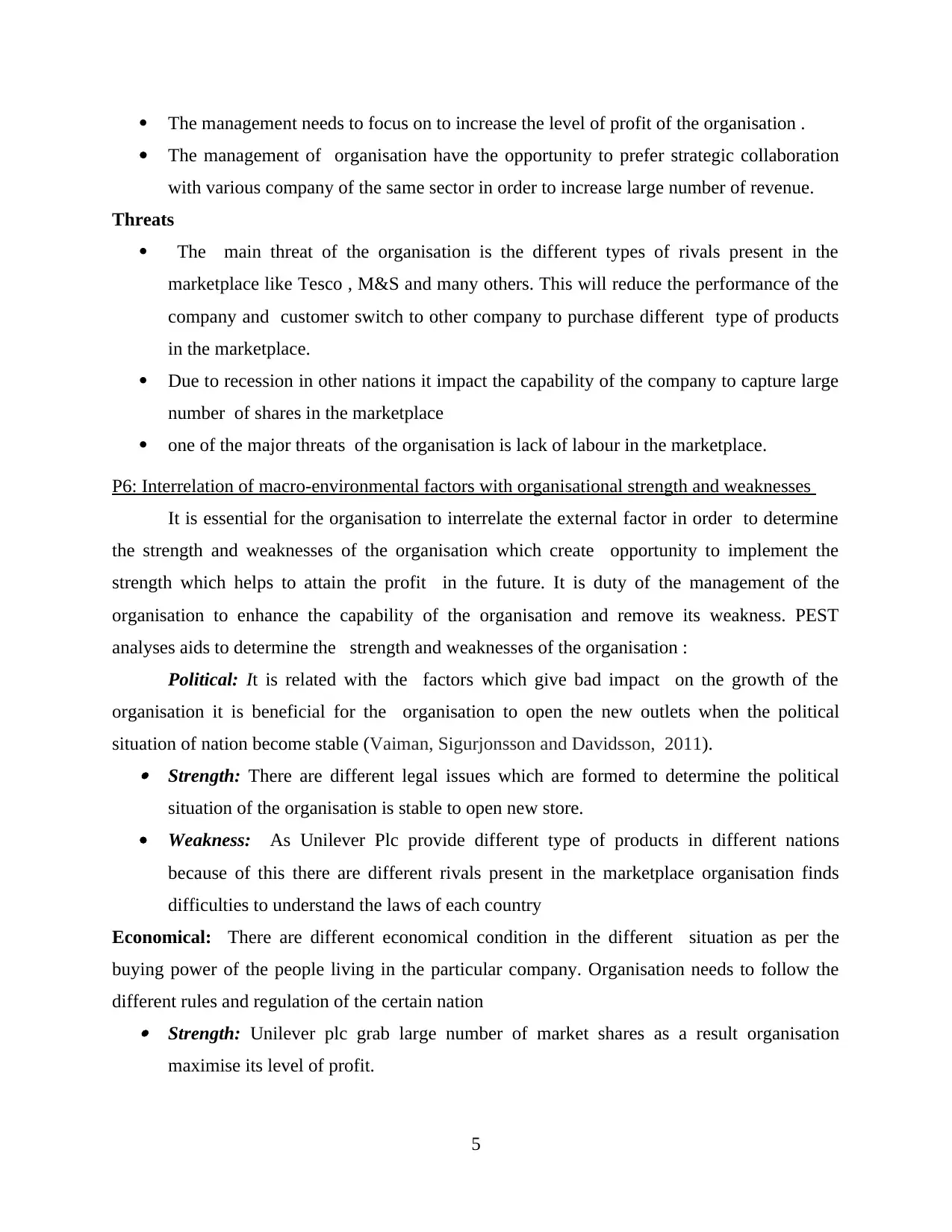
The management needs to focus on to increase the level of profit of the organisation .
The management of organisation have the opportunity to prefer strategic collaboration
with various company of the same sector in order to increase large number of revenue.
Threats
The main threat of the organisation is the different types of rivals present in the
marketplace like Tesco , M&S and many others. This will reduce the performance of the
company and customer switch to other company to purchase different type of products
in the marketplace.
Due to recession in other nations it impact the capability of the company to capture large
number of shares in the marketplace
one of the major threats of the organisation is lack of labour in the marketplace.
P6: Interrelation of macro-environmental factors with organisational strength and weaknesses
It is essential for the organisation to interrelate the external factor in order to determine
the strength and weaknesses of the organisation which create opportunity to implement the
strength which helps to attain the profit in the future. It is duty of the management of the
organisation to enhance the capability of the organisation and remove its weakness. PEST
analyses aids to determine the strength and weaknesses of the organisation :
Political: It is related with the factors which give bad impact on the growth of the
organisation it is beneficial for the organisation to open the new outlets when the political
situation of nation become stable (Vaiman, Sigurjonsson and Davidsson, 2011). Strength: There are different legal issues which are formed to determine the political
situation of the organisation is stable to open new store.
Weakness: As Unilever Plc provide different type of products in different nations
because of this there are different rivals present in the marketplace organisation finds
difficulties to understand the laws of each country
Economical: There are different economical condition in the different situation as per the
buying power of the people living in the particular company. Organisation needs to follow the
different rules and regulation of the certain nation Strength: Unilever plc grab large number of market shares as a result organisation
maximise its level of profit.
5
The management of organisation have the opportunity to prefer strategic collaboration
with various company of the same sector in order to increase large number of revenue.
Threats
The main threat of the organisation is the different types of rivals present in the
marketplace like Tesco , M&S and many others. This will reduce the performance of the
company and customer switch to other company to purchase different type of products
in the marketplace.
Due to recession in other nations it impact the capability of the company to capture large
number of shares in the marketplace
one of the major threats of the organisation is lack of labour in the marketplace.
P6: Interrelation of macro-environmental factors with organisational strength and weaknesses
It is essential for the organisation to interrelate the external factor in order to determine
the strength and weaknesses of the organisation which create opportunity to implement the
strength which helps to attain the profit in the future. It is duty of the management of the
organisation to enhance the capability of the organisation and remove its weakness. PEST
analyses aids to determine the strength and weaknesses of the organisation :
Political: It is related with the factors which give bad impact on the growth of the
organisation it is beneficial for the organisation to open the new outlets when the political
situation of nation become stable (Vaiman, Sigurjonsson and Davidsson, 2011). Strength: There are different legal issues which are formed to determine the political
situation of the organisation is stable to open new store.
Weakness: As Unilever Plc provide different type of products in different nations
because of this there are different rivals present in the marketplace organisation finds
difficulties to understand the laws of each country
Economical: There are different economical condition in the different situation as per the
buying power of the people living in the particular company. Organisation needs to follow the
different rules and regulation of the certain nation Strength: Unilever plc grab large number of market shares as a result organisation
maximise its level of profit.
5
Paraphrase This Document
Need a fresh take? Get an instant paraphrase of this document with our AI Paraphraser
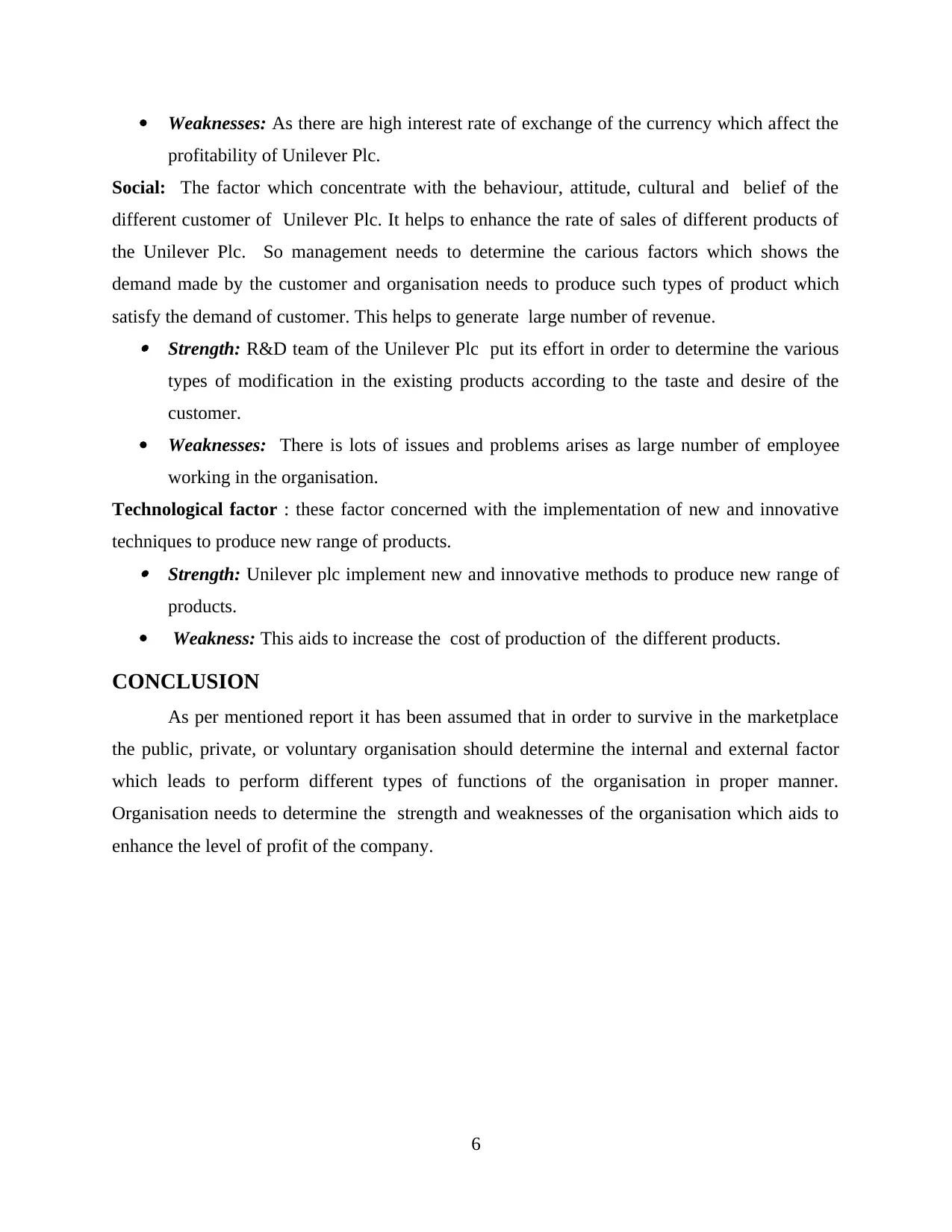
Weaknesses: As there are high interest rate of exchange of the currency which affect the
profitability of Unilever Plc.
Social: The factor which concentrate with the behaviour, attitude, cultural and belief of the
different customer of Unilever Plc. It helps to enhance the rate of sales of different products of
the Unilever Plc. So management needs to determine the carious factors which shows the
demand made by the customer and organisation needs to produce such types of product which
satisfy the demand of customer. This helps to generate large number of revenue. Strength: R&D team of the Unilever Plc put its effort in order to determine the various
types of modification in the existing products according to the taste and desire of the
customer.
Weaknesses: There is lots of issues and problems arises as large number of employee
working in the organisation.
Technological factor : these factor concerned with the implementation of new and innovative
techniques to produce new range of products. Strength: Unilever plc implement new and innovative methods to produce new range of
products.
Weakness: This aids to increase the cost of production of the different products.
CONCLUSION
As per mentioned report it has been assumed that in order to survive in the marketplace
the public, private, or voluntary organisation should determine the internal and external factor
which leads to perform different types of functions of the organisation in proper manner.
Organisation needs to determine the strength and weaknesses of the organisation which aids to
enhance the level of profit of the company.
6
profitability of Unilever Plc.
Social: The factor which concentrate with the behaviour, attitude, cultural and belief of the
different customer of Unilever Plc. It helps to enhance the rate of sales of different products of
the Unilever Plc. So management needs to determine the carious factors which shows the
demand made by the customer and organisation needs to produce such types of product which
satisfy the demand of customer. This helps to generate large number of revenue. Strength: R&D team of the Unilever Plc put its effort in order to determine the various
types of modification in the existing products according to the taste and desire of the
customer.
Weaknesses: There is lots of issues and problems arises as large number of employee
working in the organisation.
Technological factor : these factor concerned with the implementation of new and innovative
techniques to produce new range of products. Strength: Unilever plc implement new and innovative methods to produce new range of
products.
Weakness: This aids to increase the cost of production of the different products.
CONCLUSION
As per mentioned report it has been assumed that in order to survive in the marketplace
the public, private, or voluntary organisation should determine the internal and external factor
which leads to perform different types of functions of the organisation in proper manner.
Organisation needs to determine the strength and weaknesses of the organisation which aids to
enhance the level of profit of the company.
6
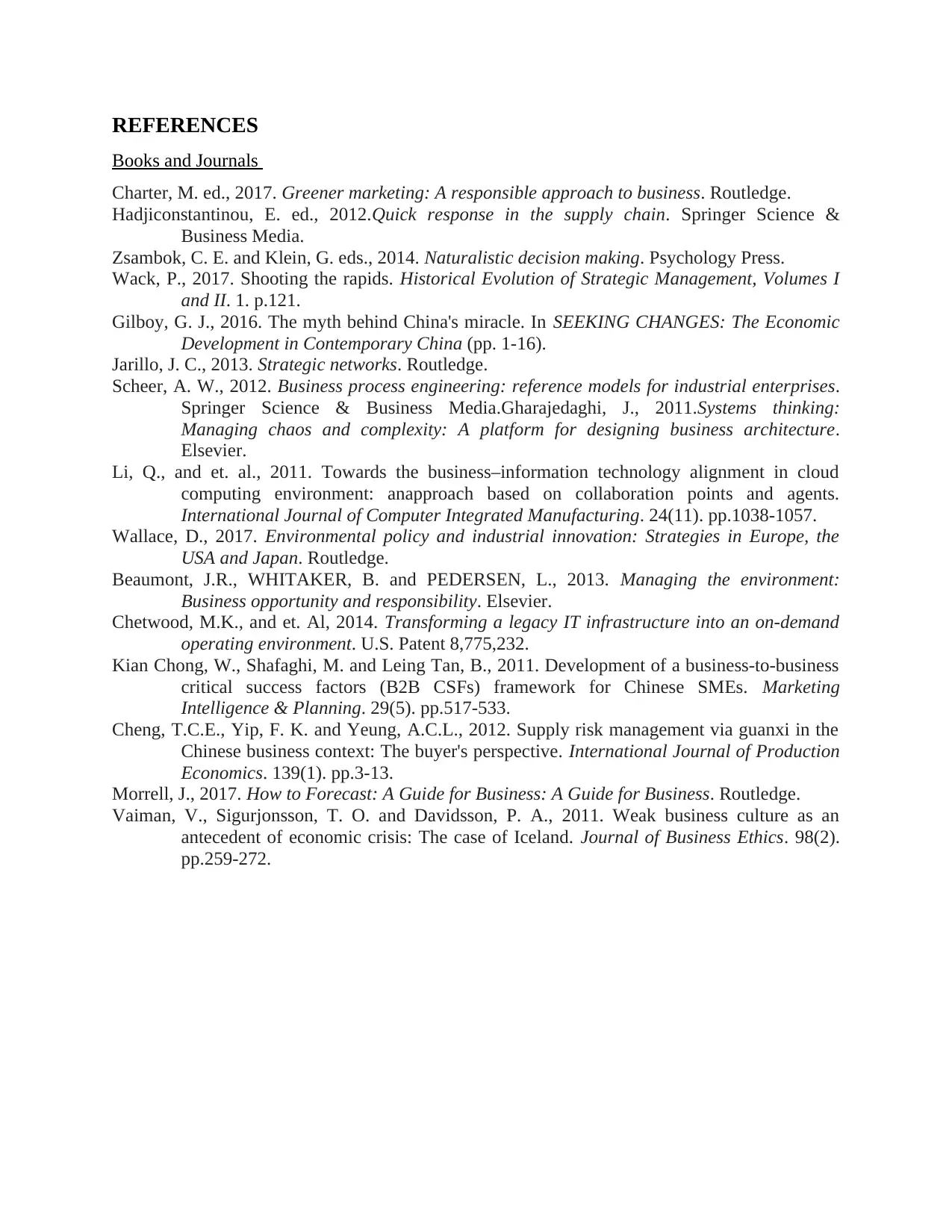
REFERENCES
Books and Journals
Charter, M. ed., 2017. Greener marketing: A responsible approach to business. Routledge.
Hadjiconstantinou, E. ed., 2012.Quick response in the supply chain. Springer Science &
Business Media.
Zsambok, C. E. and Klein, G. eds., 2014. Naturalistic decision making. Psychology Press.
Wack, P., 2017. Shooting the rapids. Historical Evolution of Strategic Management, Volumes I
and II. 1. p.121.
Gilboy, G. J., 2016. The myth behind China's miracle. In SEEKING CHANGES: The Economic
Development in Contemporary China (pp. 1-16).
Jarillo, J. C., 2013. Strategic networks. Routledge.
Scheer, A. W., 2012. Business process engineering: reference models for industrial enterprises.
Springer Science & Business Media.Gharajedaghi, J., 2011.Systems thinking:
Managing chaos and complexity: A platform for designing business architecture.
Elsevier.
Li, Q., and et. al., 2011. Towards the business–information technology alignment in cloud
computing environment: anapproach based on collaboration points and agents.
International Journal of Computer Integrated Manufacturing. 24(11). pp.1038-1057.
Wallace, D., 2017. Environmental policy and industrial innovation: Strategies in Europe, the
USA and Japan. Routledge.
Beaumont, J.R., WHITAKER, B. and PEDERSEN, L., 2013. Managing the environment:
Business opportunity and responsibility. Elsevier.
Chetwood, M.K., and et. Al, 2014. Transforming a legacy IT infrastructure into an on-demand
operating environment. U.S. Patent 8,775,232.
Kian Chong, W., Shafaghi, M. and Leing Tan, B., 2011. Development of a business-to-business
critical success factors (B2B CSFs) framework for Chinese SMEs. Marketing
Intelligence & Planning. 29(5). pp.517-533.
Cheng, T.C.E., Yip, F. K. and Yeung, A.C.L., 2012. Supply risk management via guanxi in the
Chinese business context: The buyer's perspective. International Journal of Production
Economics. 139(1). pp.3-13.
Morrell, J., 2017. How to Forecast: A Guide for Business: A Guide for Business. Routledge.
Vaiman, V., Sigurjonsson, T. O. and Davidsson, P. A., 2011. Weak business culture as an
antecedent of economic crisis: The case of Iceland. Journal of Business Ethics. 98(2).
pp.259-272.
Books and Journals
Charter, M. ed., 2017. Greener marketing: A responsible approach to business. Routledge.
Hadjiconstantinou, E. ed., 2012.Quick response in the supply chain. Springer Science &
Business Media.
Zsambok, C. E. and Klein, G. eds., 2014. Naturalistic decision making. Psychology Press.
Wack, P., 2017. Shooting the rapids. Historical Evolution of Strategic Management, Volumes I
and II. 1. p.121.
Gilboy, G. J., 2016. The myth behind China's miracle. In SEEKING CHANGES: The Economic
Development in Contemporary China (pp. 1-16).
Jarillo, J. C., 2013. Strategic networks. Routledge.
Scheer, A. W., 2012. Business process engineering: reference models for industrial enterprises.
Springer Science & Business Media.Gharajedaghi, J., 2011.Systems thinking:
Managing chaos and complexity: A platform for designing business architecture.
Elsevier.
Li, Q., and et. al., 2011. Towards the business–information technology alignment in cloud
computing environment: anapproach based on collaboration points and agents.
International Journal of Computer Integrated Manufacturing. 24(11). pp.1038-1057.
Wallace, D., 2017. Environmental policy and industrial innovation: Strategies in Europe, the
USA and Japan. Routledge.
Beaumont, J.R., WHITAKER, B. and PEDERSEN, L., 2013. Managing the environment:
Business opportunity and responsibility. Elsevier.
Chetwood, M.K., and et. Al, 2014. Transforming a legacy IT infrastructure into an on-demand
operating environment. U.S. Patent 8,775,232.
Kian Chong, W., Shafaghi, M. and Leing Tan, B., 2011. Development of a business-to-business
critical success factors (B2B CSFs) framework for Chinese SMEs. Marketing
Intelligence & Planning. 29(5). pp.517-533.
Cheng, T.C.E., Yip, F. K. and Yeung, A.C.L., 2012. Supply risk management via guanxi in the
Chinese business context: The buyer's perspective. International Journal of Production
Economics. 139(1). pp.3-13.
Morrell, J., 2017. How to Forecast: A Guide for Business: A Guide for Business. Routledge.
Vaiman, V., Sigurjonsson, T. O. and Davidsson, P. A., 2011. Weak business culture as an
antecedent of economic crisis: The case of Iceland. Journal of Business Ethics. 98(2).
pp.259-272.
⊘ This is a preview!⊘
Do you want full access?
Subscribe today to unlock all pages.

Trusted by 1+ million students worldwide
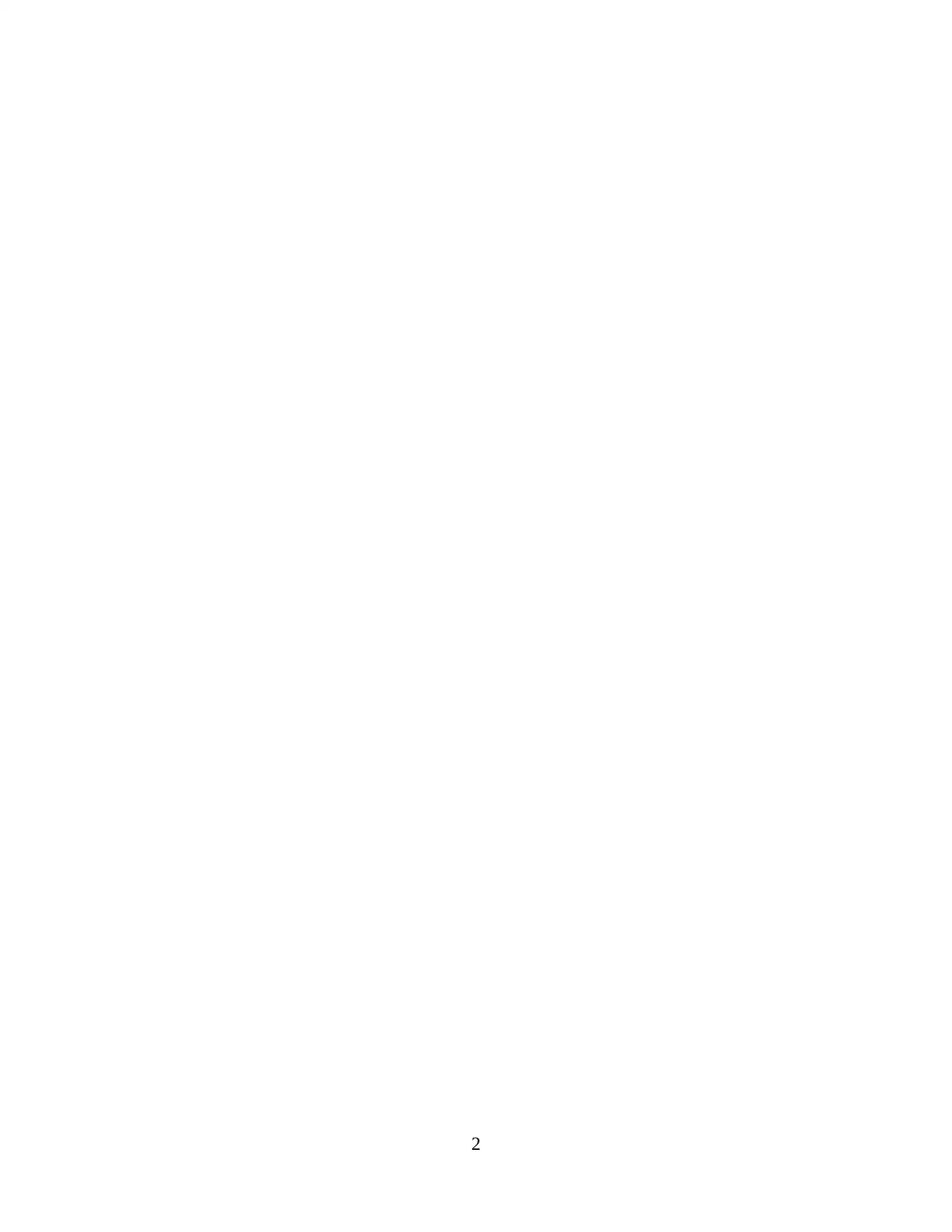
2
1 out of 10
Related Documents
Your All-in-One AI-Powered Toolkit for Academic Success.
+13062052269
info@desklib.com
Available 24*7 on WhatsApp / Email
![[object Object]](/_next/static/media/star-bottom.7253800d.svg)
Unlock your academic potential
Copyright © 2020–2025 A2Z Services. All Rights Reserved. Developed and managed by ZUCOL.





